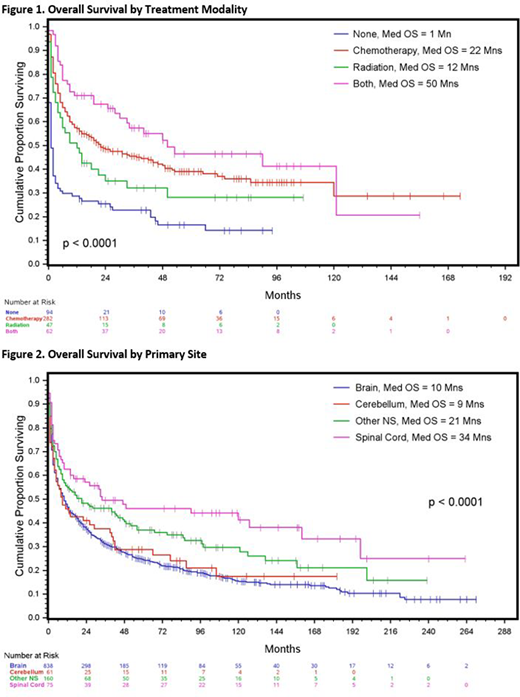Introduction
Primary or secondary central nervous system (CNS) lymphoma is a rare and aggressive disease. Prior database analyses have enriched our knowledge of the epidemiology, clinical presentation and prognosis for these patients, although data regarding treatment patterns and long-term survival data is lacking. Ours is the first study investigating epidemiology, clinical characteristics, treatment patterns and potential prognostic factors using the Texas Cancer Registry (TCR). This is a statewide database, population-based registry that serves as the foundation for measuring the cancer burden in Texas and it is one of largest cancer registries in the United States1.
Methods
We used the TCR database to retrospectively identify patients diagnosed with CNS lymphoma from 1997 to 2017. Data collected included age, race, histology (diffuse large B-cell lymphoma, T-cell lymphoma), location and outcomes (alive/dead). Treatment (chemotherapy, radiation therapy or both) data was collected from 2004 to 2017. Differences in patient-level characteristics between cohorts were compared using a chi-square test and Fisher's exact test as appropriate. Survival was analyzed using the Kaplan-Meier method and log-rank tests were used to compare survival distributions. P < 0.05 was considered statistically significant for all analysis.
Results
There were 1134 patients with CNS lymphoma identified between 1995 and 2017. Most of them were diffuse large B-cell lymphoma (DLBCL) (97.4%); only 22 patients had T cell lymphoma. The most common locations were brain (73.9%), unspecified (14.1%) and spinal cord (6.7%). Almost 50% of all patients were over 65 years old; male to female ratio was 1.23. Patients were frequently reported to be Caucasian (62.7%) followed by Hispanic (27.0%) and African-american (6.9%). The median follow-up time was 11 months.
Treatment data was available for 485 patients. They either received chemotherapy (58.1%), radiation (9.7%) or both (12.8%). Survival was better for patients receiving chemotherapy and radiation than radiation alone (HR 1.8, p=0.02) or no treatment (HR 3.3, p < 0.0001). There was no statistically significant difference when compared with chemotherapy alone (HR 1.4, p= 0.0931) (Figure 1).
Overall survival (OS) for patients with DLBCL at 5-years was 27.4 % (95% CI: 24.7%, 30.1%) and 42.0% for T-cell (95% CI: 23.9%, 59.0%). Five-year disease specific survival (DSS) was similar at 39.2% (95% CI: 35.9%, 42.5%) for DLBCL and 51.8% for T-cell lymphoma (95% CI: 30.3%, 69.5%). There was no statistically significant difference between these two cohorts for OS (p = 0.5063) and DSS (p=0.2819). Age over 65 years was associated with poor survival (32 months vs 6 months, p<0.0001). Spinal cord involvement was associated with a better prognosis than other nervous system, cerebellum, or brain (34 months vs 21 months vs 9 months vs 10 months, p < 0.0001) (Figure 2).
Conclusion
CNS lymphoma is a rare lymphoma presentation. Most of them are DLBCL and commonly found in patients older than 65 years old. Spinal cord disease alone was associated with a better prognosis and age over 65 years old was associated with a worse outcome. Treatment with chemotherapy (either with radiation or alone) is associated with better outcomes.
1. Cancer incidence data have been provided by the Texas Cancer Registry, Cancer Epidemiology and Surveillance Branch, Texas Department of State Health Services, 1100 West 49th Street, Austin, TX 78756, https://www.dshs.texas.gov/tcr/.
No relevant conflicts of interest to declare.
Author notes
Asterisk with author names denotes non-ASH members.


This feature is available to Subscribers Only
Sign In or Create an Account Close Modal